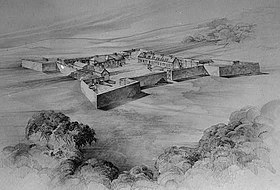Fort Frederick State Park
| Fort Frederick State Park | |
| Maryland State Park | |
| Country | United States |
|---|---|
| State | Maryland |
| County | Washington |
| Elevation | 472 ft (144 m) |
| Coordinates | 39°36′36″N 78°00′12″W / 39.61000°N 78.00333°WCoordinates: 39°36′36″N 78°00′12″W / 39.61000°N 78.00333°W |
| Area | 722 acres (292 ha) |
| Established | 1922 |
| Management | Maryland Department of Natural Resources |
| Website: Fort Frederick State Park | |
|
Fort Frederick
|
|

Rendering of Fort Frederick as it may have appeared
in the 18th century |
|
| Location | Washington County, Maryland, USA |
| Nearest city | Big Pool, Maryland |
| Area | 287 acres (116 ha) |
| Built | 1756-58 |
| NRHP Reference # | 73000939 |
| Significant dates | |
| Added to NRHP | November 7, 1973 |
| Designated NHL | November 7, 1973 |
Fort Frederick State Park is a Maryland state park surrounding the restored Fort Frederick, a star fort active in the French and Indian War (1754–1763) and the American Revolutionary War (1775-1783). The park is south of the town of Big Pool on the Potomac River; the Chesapeake and Ohio Canal runs through the park grounds. The site was designated a National Historic Landmark in 1973.
Fort Frederick was built in 1756-57 by the colony of Maryland. During the French and Indian War in 1756, a £6000 appropriation was authorized by the Maryland Legislature at the request of Governor Horatio Sharpe to build a fortification on the frontier. The fort, named after Frederick Calvert, 6th Baron Baltimore, was completed the following year. "The fort's design, which was developed by Sebastian Vauban, a French engineer, is a large square with four diamond-shaped bastions. This is typical of 18th century fortifications. The fort is built of native sandstone."
The large stone fort was designed primarily as a place of refuge for area settlers. Between 1757 and 1758, small raids by Indians in nearby settlements caused settlers in the surrounding countryside to flee eastward. At the same time men of the 60th Regiment of Foot and local militia soldiers garrisoned the fort. Ranging parties were sent from the fort to patrol the area and to deter if not prevent Indian raids.
The fort was not designed to resist artillery, as it was correctly assumed that the French would not be able to transport artillery to the remote location from the west. The fort served its purpose in 1763 during Pontiac's Rebellion; however, the fort was never directly attacked.
...
Wikipedia



